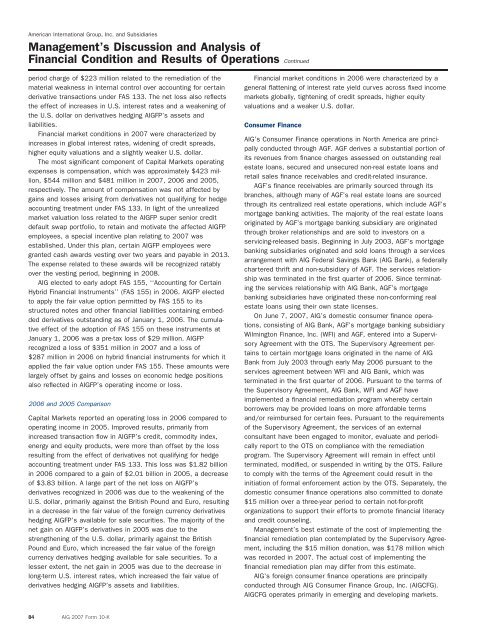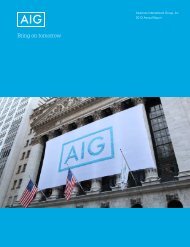2007 Annual Report - AIG.com
2007 Annual Report - AIG.com
2007 Annual Report - AIG.com
Create successful ePaper yourself
Turn your PDF publications into a flip-book with our unique Google optimized e-Paper software.
American International Group, Inc. and Subsidiaries<br />
Management’s Discussion and Analysis of<br />
Financial Condition and Results of Operations Continued<br />
<strong>AIG</strong>’s Consumer Finance operations in North America are princi-<br />
pally conducted through AGF. AGF derives a substantial portion of<br />
its revenues from finance charges assessed on outstanding real<br />
estate loans, secured and unsecured non-real estate loans and<br />
retail sales finance receivables and credit-related insurance.<br />
AGF’s finance receivables are primarily sourced through its<br />
branches, although many of AGF’s real estate loans are sourced<br />
through its centralized real estate operations, which include AGF’s<br />
mortgage banking activities. The majority of the real estate loans<br />
originated by AGF’s mortgage banking subsidiary are originated<br />
through broker relationships and are sold to investors on a<br />
servicing-released basis. Beginning in July 2003, AGF’s mortgage<br />
banking subsidiaries originated and sold loans through a services<br />
arrangement with <strong>AIG</strong> Federal Savings Bank (<strong>AIG</strong> Bank), a federally<br />
chartered thrift and non-subsidiary of AGF. The services relation-<br />
ship was terminated in the first quarter of 2006. Since terminating<br />
the services relationship with <strong>AIG</strong> Bank, AGF’s mortgage<br />
banking subsidiaries have originated these non-conforming real<br />
estate loans using their own state licenses.<br />
On June 7, <strong>2007</strong>, <strong>AIG</strong>’s domestic consumer finance operations,<br />
consisting of <strong>AIG</strong> Bank, AGF’s mortgage banking subsidiary<br />
Wilmington Finance, Inc. (WFI) and AGF, entered into a Supervisory<br />
Agreement with the OTS. The Supervisory Agreement per-<br />
tains to certain mortgage loans originated in the name of <strong>AIG</strong><br />
Bank from July 2003 through early May 2006 pursuant to the<br />
services agreement between WFI and <strong>AIG</strong> Bank, which was<br />
terminated in the first quarter of 2006. Pursuant to the terms of<br />
the Supervisory Agreement, <strong>AIG</strong> Bank, WFI and AGF have<br />
implemented a financial remediation program whereby certain<br />
borrowers may be provided loans on more affordable terms<br />
and/or reimbursed for certain fees. Pursuant to the requirements<br />
of the Supervisory Agreement, the services of an external<br />
consultant have been engaged to monitor, evaluate and periodi-<br />
cally report to the OTS on <strong>com</strong>pliance with the remediation<br />
program. The Supervisory Agreement will remain in effect until<br />
terminated, modified, or suspended in writing by the OTS. Failure<br />
to <strong>com</strong>ply with the terms of the Agreement could result in the<br />
initiation of formal enforcement action by the OTS. Separately, the<br />
domestic consumer finance operations also <strong>com</strong>mitted to donate<br />
$15 million over a three-year period to certain not-for-profit<br />
organizations to support their efforts to promote financial literacy<br />
and credit counseling.<br />
Management’s best estimate of the cost of implementing the<br />
financial remediation plan contemplated by the Supervisory Agreement,<br />
including the $15 million donation, was $178 million which<br />
was recorded in <strong>2007</strong>. The actual cost of implementing the<br />
financial remediation plan may differ from this estimate.<br />
<strong>AIG</strong>’s foreign consumer finance operations are principally<br />
conducted through <strong>AIG</strong> Consumer Finance Group, Inc. (<strong>AIG</strong>CFG).<br />
<strong>AIG</strong>CFG operates primarily in emerging and developing markets.<br />
period charge of $223 million related to the remediation of the<br />
material weakness in internal control over accounting for certain<br />
derivative transactions under FAS 133. The net loss also reflects<br />
the effect of increases in U.S. interest rates and a weakening of<br />
the U.S. dollar on derivatives hedging <strong>AIG</strong>FP’s assets and<br />
liabilities.<br />
Financial market conditions in <strong>2007</strong> were characterized by<br />
increases in global interest rates, widening of credit spreads,<br />
higher equity valuations and a slightly weaker U.S. dollar.<br />
The most significant <strong>com</strong>ponent of Capital Markets operating<br />
expenses is <strong>com</strong>pensation, which was approximately $423 mil-<br />
lion, $544 million and $481 million in <strong>2007</strong>, 2006 and 2005,<br />
respectively. The amount of <strong>com</strong>pensation was not affected by<br />
gains and losses arising from derivatives not qualifying for hedge<br />
accounting treatment under FAS 133. In light of the unrealized<br />
market valuation loss related to the <strong>AIG</strong>FP super senior credit<br />
default swap portfolio, to retain and motivate the affected <strong>AIG</strong>FP<br />
employees, a special incentive plan relating to <strong>2007</strong> was<br />
established. Under this plan, certain <strong>AIG</strong>FP employees were<br />
granted cash awards vesting over two years and payable in 2013.<br />
The expense related to these awards will be recognized ratably<br />
over the vesting period, beginning in 2008.<br />
<strong>AIG</strong> elected to early adopt FAS 155, ‘‘Accounting for Certain<br />
Hybrid Financial Instruments’’ (FAS 155) in 2006. <strong>AIG</strong>FP elected<br />
to apply the fair value option permitted by FAS 155 to its<br />
structured notes and other financial liabilities containing embedded<br />
derivatives outstanding as of January 1, 2006. The cumula-<br />
tive effect of the adoption of FAS 155 on these instruments at<br />
January 1, 2006 was a pre-tax loss of $29 million. <strong>AIG</strong>FP<br />
recognized a loss of $351 million in <strong>2007</strong> and a loss of<br />
$287 million in 2006 on hybrid financial instruments for which it<br />
applied the fair value option under FAS 155. These amounts were<br />
largely offset by gains and losses on economic hedge positions<br />
also reflected in <strong>AIG</strong>FP’s operating in<strong>com</strong>e or loss.<br />
2006 and 2005 Comparison<br />
Capital Markets reported an operating loss in 2006 <strong>com</strong>pared to<br />
operating in<strong>com</strong>e in 2005. Improved results, primarily from<br />
increased transaction flow in <strong>AIG</strong>FP’s credit, <strong>com</strong>modity index,<br />
energy and equity products, were more than offset by the loss<br />
resulting from the effect of derivatives not qualifying for hedge<br />
accounting treatment under FAS 133. This loss was $1.82 billion<br />
in 2006 <strong>com</strong>pared to a gain of $2.01 billion in 2005, a decrease<br />
of $3.83 billion. A large part of the net loss on <strong>AIG</strong>FP’s<br />
derivatives recognized in 2006 was due to the weakening of the<br />
U.S. dollar, primarily against the British Pound and Euro, resulting<br />
in a decrease in the fair value of the foreign currency derivatives<br />
hedging <strong>AIG</strong>FP’s available for sale securities. The majority of the<br />
net gain on <strong>AIG</strong>FP’s derivatives in 2005 was due to the<br />
strengthening of the U.S. dollar, primarily against the British<br />
Pound and Euro, which increased the fair value of the foreign<br />
currency derivatives hedging available for sale securities. To a<br />
lesser extent, the net gain in 2005 was due to the decrease in<br />
long-term U.S. interest rates, which increased the fair value of<br />
derivatives hedging <strong>AIG</strong>FP’s assets and liabilities.<br />
Financial market conditions in 2006 were characterized by a<br />
general flattening of interest rate yield curves across fixed in<strong>com</strong>e<br />
markets globally, tightening of credit spreads, higher equity<br />
valuations and a weaker U.S. dollar.<br />
Consumer Finance<br />
84 <strong>AIG</strong> <strong>2007</strong> Form 10-K

















